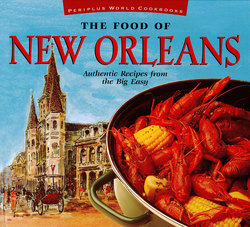Читать книгу The Food of New Orleans - John DeMers - Страница 10
На сайте Литреса книга снята с продажи.
ОглавлениеThe New Orleans Bar
A lively historical reflection on the city's "spiritual" life
by John DeMers
Thanks to its roots in the ever-imbibing Mediterranean world and its own much-proclaimed "Mardi Gras mentality," New Orleans and drinking have sounded natural in the same sentence as long as people have been talking about us. That, of course, is a very long time.
It follows that the city has made significant contributions to the history of the American cocktail — perhaps even the word cocktail itself. According to the preferred local legend (there are other, non-New Orleans theories, but none carries any more weight), it all goes back to Antoine Peychaud.
If the man's name is now known primarily in association with Peychaud bitters, his fame strikes to the heart of America's history as a hard-drinking young nation. Peychaud, we're told, came to New Orleans from the Caribbean island of Santo Domingo in the late 1700s after a particularly violent slave uprising there. Many upper-crust planters made the crossing then, with the same save-their-skins idea in mind.
An oversized concoction known as the Hurricane, as created at Pat O'Brien's bar, dwarfs more reasonably-sized New Orleans libations.
Once settled in the Crescent City, Peychaud took to dispensing a brandy-based cure-all from his apothecary on Royal Street. He eased a new word into the English language by serving this welcome relief in the larger side of a double-ended egg cup, known in French as a coquetier.
With this city's long-appreciated penchant for mispronunciation, coquetier quickly became cock-tay and then finally cocktail According to the story, the idea of having a drink just because you felt like it spread from here to the rest of the still-young United States, and the New Orleans name cocktail went along with it.
Over the years, and into our own day, great New Orleans drinks remain the stuff of tourist excesses as well as local celebrations. Even with the evolution of public taste away from hard liquor and more toward white wine, it's hard to imagine New Orleans without Hurricanes, Sazeracs, Ramos Gin Fizzes, and a handful of other drinks either invented here or taken to a higher level so skillfully that they became "ours" nonetheless.
"When you go to New Orleans, my son," said a newspaper in the 1880s, "drink a Sazerac cocktail for me and one for yourself." Pride of place among local drinks is owned by this concoction of whiskey, sugar, bitters, and an anise-flavored cordial. The cocktail took its name from a French brandy put out by a company called Sazerac-du-Forge. The brandy was imported by John Schiller, who opened the Sazerac Coffee House in 1850 at No. 13 Exchange Alley.
When Thomas Handy took over the place in 1870, he adjusted the recipe to include just a dash of absinthe and a splash of red Peychaud bitters. Ironically, he replaced the brandy that had given the drink its name with American-made whiskey.
When the use of absinthe was banned in the United States in 1912, liqueurs like Ojen from Spain, Pernod from France, or Herbsaint from Louisiana were substituted to achieve the same touch of anise.
Today, the name Sazerac is diligently protected by the Sazerac Co., which actually licenses it to the Sazerac Bar at the Fairmont Hotel, which in turn served more than its share of the cocktails when it was the high-rolling Roosevelt.
The Hurricane (a newcomer compared with the Sazerac), made with passion-fruit flavoring, dark rum, and citrus juices, was created as a promotion at Pat O'Brien's Irish bar.
With the astronomical success of the Hurricane, the bar has even spun off a glass whose shape is recognizable anywhere—it is a footed glass, rounded at the bottom and tapering to a flared cylinder at the top. It is particularly well-known on Bourbon Street in the wee hours of the morning. Pat O's has given birth to other drinks bearing names like Cyclone, Squall, and Breeze.
Another historic favorite, the gin fizz (made of cream, gin, lemon juice, orange flower water, and egg whites) was created by Henry C. Ramos, a New Orleans bar owner who arrived in the city in 1888. At the time Ramos's Imperial Cabinet had a huge squad of bartenders, as many as thirty-five pouring out gin fizz after gin fizz during Carnival of 1915. The drink was a favorite of Louisiana governor Huey Long, who associated it with the bar at his beloved Roosevelt Hotel. When Long moved to Washington to serve in the U.S. Senate, he at first despaired of keeping the Ramos supply lines open. Eventually, the Kingfish imported his own bartender from New Orleans and made the drink, quite literally, the toast of the capital.
Along with the Sazerac, the Absinthe Suissesse and the Absinthe Frappe were the most famous New Orleans drinks associated with the namesake ingredient before its ban. Today, absinthe is typically replaced with Ojen.
A local variant on the Brandy Alexander that became a nationwide fad during Prohibition, Brandy Milk Punch, the primal version of the smoothie made of brandy, cream, sugar syrup, and egg, is great as a brunch aperitif. According to local lore, which invariably fights firewater with firewater, the Brandy Milk Punch helps cure hangovers.
We may not sip cool mint juleps on plantation verandahs, but on a hot New Orleans summer day there is nothing better than sitting on a French Quarter balcony, glass in hand, and watching the world go by.
